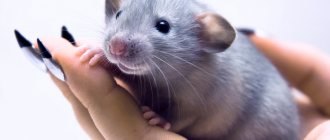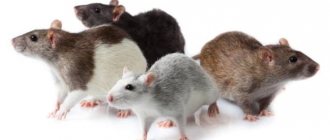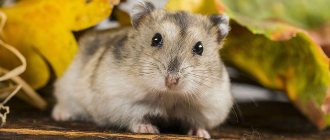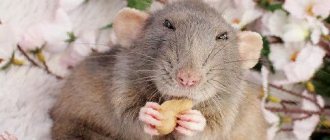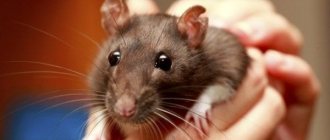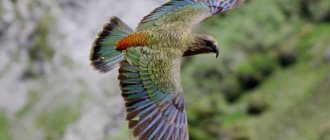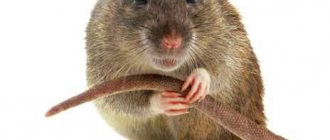- Wild animals
- >>
- Mammals
Contrary to popular stereotypes, a rat can be not only a minor pest and a carrier of especially dangerous diseases, but also a real pet, causing affection among all family members. Especially when it comes to ornamental animals! The Dumbo rat seems to be created to live with a person!
Appearance
Dumbo differs from an ordinary rat in his ears - they are low-set and quite large. Moreover, the larger the ears, the more valuable the representative of the breed.
There are two types of auricles:
- The saucer shape is flat and round.
- Bud shape - they have sharp tips and are slightly curled inward, which is why they resemble small flower buds.
Reference! Dumbo with bud-shaped ears are very popular in European countries.
Pet health
Caring for and maintaining a Dumbo rat involves caring for the health of the animal. Representatives of the Dumbo breed are prone to respiratory diseases. They also have tumors and abscesses. Often, long-eared rats develop conjunctivitis. If alarming symptoms are detected, it is necessary to take your pet to a veterinarian as soon as possible.
Signs of illness in Dumbo rats are:
- greasy, unkempt wool;
- lethargy, apathy;
- loss of appetite;
- redness of the eyes, tearing;
- nasal discharge;
- hard breath;
- the appearance of bald spots and scratches on the skin;
- bumps on the body.
The owner must follow the veterinarian's recommendations. The cage is moved to a warm place and try not to disturb the animal. It is important to make sure your rat drinks water. Otherwise, you will have to unsolder it from a pipette or syringe without a needle.
Important! If a pet is diagnosed with an infectious disease, then it must be isolated from other rats and placed in another cage.
Main characteristics
Dumbo differs from its relatives in the following parameters:
- Body. The body is shorter and stockier. The size of an adult varies from 16 to 21 cm, weight - from 240 to 410 grams. Males are noticeably larger than females.
- Head. Round, muzzle elongated and sharp.
- Wool. Color and structure are variable.
- Tail. By standard, the tail is long and quite thick. There are also tailless varieties.
Animal character
Breeders identify three temperaments characteristic of Dumbo:
- Learning ability. With regular training, the rodent quickly becomes tamed and learns to perform simple tricks.
- Laziness. This point follows from the first - the rat quickly understands the cause-and-effect relationship “following the command - a treat” and becomes lazy if it sees that there will be no reward.
- Friendliness. Dumbo loves to spend time with his owner. They take the initiative to get to know other household members. However, if the owner spends a lot of time outside the home, the pet may get bored. Therefore, veterinarians advise having two same-sex individuals at once.
Diseases
The poor health of the animal is difficult not to notice. A healthy rat is always cheerful and cheerful, plays and runs a lot, has clear eyes and shiny fur. If you notice that your pet is acting differently or looks unwell, it is best to contact a veterinarian immediately.
The most common diseases in rats are:
- Mycoplasmosis. The animal can pick it up by airborne droplets; Complications may develop and pneumonia may appear. This disease can be fatal to the animal.
- Abscesses. Appears when a pet is injured. In this case, it is necessary to open and disinfect the outbreak.
- Benign and malignant tumors.
- Parasites. Rats are not given anthelmintic drugs for prevention; they are used only when the disease already exists.
What do you name the rat Dumbo?
Look at your new eared pet, think about what you could call him? Perhaps his character and appearance remind you of some character from a fairy tale, book or cartoon? If you find it difficult to choose, then use our lists!
| Names for boy rats: | Names for girls: |
|
|
You can find out more about names in the article - What to name a pet rat?
What varieties are there?
As a result of selection, the following notable subspecies of Dumbo rats were obtained.
Rex
The body is covered with curly, dense hair. In young rats, the hairs stick out funny in different directions, as the curls are just forming. In some cases, even the mustache curls.
A healthy individual has no bald spots or bald spots on the body - the hair evenly covers the entire body. The skin is soft and plush to the touch.
Reference! Dumbo Rex is a subspecies that has not yet been included in the breed standards.
Sphinx
Just like cats of the same breed, Dumbo Sphinx rats are completely hairless. Their skin is soft, velvety, folded. The mustache may be short, curled, or absent altogether.
Due to their peculiarity, they often injure the skin and contract infectious and viral diseases. If you are planning to get two rats at the same time, then keep in mind that only their breed can be added to Sphynxes.
Other rats may be quite aggressive towards them, due to the specific appearance associated with the disease.
Siamese
The fur on the body is a delicate, light cream color, and the muzzle and paws are outlined in dark brown. The gene for this color is recessive, so it is passed on from generation to generation quite rarely. This explains the high price for baby rats.
Husky
Dumbo Husky rat pups are born in a completely standard color: brown, gray or black. Only with age do the snow-white hairs characteristic of this color begin to appear on the fur coat.
Manx
Breeders still treat this subspecies rather coldly and oppose the breeding of such individuals. The fact is that the absence of a tail in Dumbo-Monx is a consequence of a complex mutation. Taillessness for a rodent means a loss of balance and the inability to cool the body in moments of overheating.
Manx often have serious problems with the musculoskeletal system, due to which they rarely live to be a year old.
Blue
The Blue Dumbo has a light gray coat with a noticeable bluish tint. It is quite rare, which is why breeders often raise the price of rat pups.
Choosing a name, examples of names
Every owner wants to choose a bright and original name for their pet. If you follow simple rules, the chosen name for the Dumbo rat will fully meet these requirements:
- it should be easy to understand and short (bad: Archibald, Wilhelmina; good: Archie, Willie);
- It is advisable to use sonorant (r, l, m, n) and hissing (zh, sh, ts, h) consonants in the nickname (bad: Doug, Alice; good: Ricky, Mila).
It is best to purchase a rat from a nursery. This will not only allow you to gain confidence in the authenticity of the chosen breed, but will also significantly expand the number of possible options for the color and texture of the coat. In addition to the usual rodent of this breed, you can buy there:
- Siamese
- rex
- blue
- husky
- white
Is it worth getting Dumbo the rat as a pet? Advantages and disadvantages
A pet rat can be a full-fledged four-legged friend. To understand whether such an animal is right for you, you should weigh all the advantages and disadvantages.
Pros:
- can be kept even in small housing;
- have a friendly disposition;
- clean;
- don't make noise;
- maintenance does not require large financial costs;
- easy care.
Minuses:
- without regular tactile contact with humans, rats may never be tamed;
- not suitable for people who spend most of their time at work, as animals need communication;
- cats and dogs can attack a rodent due to their hunting instinct.
Housing
When choosing a cage, you need to remember that it should be comfortable and spacious. It is better to give preference to multi-tiered cells. Also remember that items made from plastic and wood are not suitable as rodents will destroy such items in a short time. The cage must be metal, the length must be at least 60 cm, and the width must be at least 50 cm.
In addition to the size of the cage, attention must be paid to other parameters, namely, the distance between the rods should be no more than 20 mm. The tray should be high, the floor should be level, and the door should be wide. A house and a hammock must be installed in the cage. The house is installed so that the animal can hide when it is scared, or is tired of attention, wants to sleep or just relax.
Be sure to arrange an area for eating, in which bowls and a drinking bowl are installed. You will need several bowls, since you cannot mix natural products and feed.
It is better to purchase a special drinking bowl that is fixed on the cage, so the water will stay clean longer and will not spill. Remember that the cage is regularly cleaned and washed, and be sure to wash all accessories.
Regarding entertainment and games in the cage, they must be present. When a person is busy, the animal must entertain itself independently. Specialized stores offer a fairly wide range of all kinds of entertainment accessories.
You can purchase ropes, tunnels, ladders. Many owners make toys themselves. An important element in the cage is a special mineral stone, which helps the rodent to properly grind down its teeth and claws.
Regarding aquariums that are offered to be purchased instead of cages, this housing is not suitable for rodents, and experienced breeders categorically do not recommend them; they note the following disadvantages:
- Due to the blank walls, there is very poor ventilation in the middle.
- Fecal gases and an unpleasant odor accumulate inside.
- The cleaning and cleaning procedure is quite difficult.
- Regular disinfection is necessary.
Dumbo - what to feed?
In most cases, breeders give preference to ready-made feed mixtures of grains, nuts, and bran. But this does not mean that the pet does not need additional feeding. To replenish protein reserves, she can be given boiled chicken fillet, liver or heart. Fresh apples, peaches, bananas and cherries are good treats.
Important! Do not give your rodent dried fruits - they contain too much sugar.
Many inexperienced breeders often feed rats from the table, believing that this will not harm their strong immunity. This is a dangerous misconception! Foods that are too fatty, salty, spicy or hot can cause indigestion, bloat, and even death.
Knowing this, you should exclude from your diet:
- fatty meats and fish;
- baked goods, confectionery products;
- cheese;
- cabbage;
- radishes, horseradish, turnips;
- raw and fried potatoes;
- artichokes;
- all legumes;
- mushrooms.
The rats are fed 2 times a day - morning and evening. Adults twice as often. It is important to ensure that your pet always has clean drinking water.
In limited quantities, dairy and fermented milk products and citrus fruits can be given as treats.
Lifespan
The average lifespan of sphinxes is 2-2.5 years. This is slightly less than the age of rats of other breeds. Premature death is explained by the predisposition of hairless rodents to a variety of diseases, for example:
- renal and liver failure;
- neoplasms;
- diabetes;
- pathologies of the heart and blood vessels;
- stroke;
- allergic reactions;
- cystitis.
In addition, due to the lack of fur, Sphynx cats are prone to developing colds. Additional problems are caused by exposure to direct sunlight. Under the sun, the rat becomes very overheated, even to the point of heatstroke. And on delicate skin, symptoms of dermatitis appear or burns form.
It is worth noting that despite all the health problems, if the animal is provided with proper care and periodic preventive examinations by a veterinarian, the life expectancy of a hairless rat can be more than 3 years.
Care and maintenance
In order for a pet to feel comfortable, it must be provided with appropriate living conditions.
Cell
The best solution for housing is a spacious, multi-story metal cage. When purchasing, make sure that it does not contain wooden or metal fittings, as a rat will quickly chew through it.
First of all, you need to decide how many animals you will have. As stated earlier, the minimum is 2 rats. The minimum dimensions of the cage are height 50 cm, length 60 m, width 40 cm.
For temporary housing (mooring a sick animal, etc.), smaller cages can be used.
The width of the rods should be less than 2 cm, otherwise the animal will simply squeeze through and run away.
Place to sleep and relax
The house should be quite large so that the rat can completely hide in it and lie down comfortably. The preferred material is durable, thick plastic. It does not absorb odors, is easy to disassemble and clean.
A hammock is a suspended structure made of soft fabric, closed or open, in which a rodent can hide from the cold and prying eyes.
Many rats willingly doze in hammocks, which looks extremely funny, but, unfortunately, this design is very short-lived and quickly absorbs the smell of the cage. It is better to have several in reserve, while one hammock is in the wash, the animal sleeps in the other.
Important! If several rats live in one cage, each of them should have its own house or hammock.
Drinking bowl and other utensils
The most preferred material for bowls is thick ceramic. Such a plate is difficult to turn over, and it does not make noise when the pet is sorting through the food. There should be 2 bowls - one for industrial food, the second for complementary foods in the form of vegetables, meat and fruits.
If there are two Dumbo rats living in a cage, purchase a long bowl with bars attached, or place a large plate in the center of the cage. This will allow pets to eat freely without disturbing each other.
As for drinkers, the most preferable option is a ball drinker with a grate attachment. This design allows you to keep water clean and fresh for a very long time. The downside of this type of drinker is that it makes a lot of noise, and the ball can get stuck inside the tube.
Toys
The rat, unlike other pets, is not allowed to roam freely around the house. But sitting in a cage all the time can lead to obesity and mental problems.
To prevent the animal from getting bored, place ladders and ropes inside the cage. Special pipe labyrinths for rodents are also good. They can be purchased at a pet store or made yourself.
Features of feeding
Dumbo rats are omnivores, but there are still some dietary restrictions. Pets are prone to allergies and, unlike their wild counterparts, sometimes suffer from digestive problems.
The basis of the diet of the dumbo rat is grain. Pet stores sell special food for small rodents, which includes:
- millet;
- barley;
- buckwheat;
- lentils;
- nuts;
- herbal granules;
- raisin;
- sunflower seeds;
- pumpkin seeds.
How to maintain hygiene?
Dumbos are very clean and take good care of their coat. Once every six months, you can bathe your pet to get rid of the specific rodent odor. In this case, it is better to use a specialized shampoo.
Teach your pet in advance to the feeling of water on his skin so that bathing does not become stressful for him. Do this in a playful way: let your pet try to get a toy or treat from a bowl with warm water at the bottom. Pleasant associations will allow the animal to calmly undergo hygiene procedures.
Note! You need to change the filler in the cage at least twice a week!
Reproduction and offspring
Dumbo reaches sexual maturity at 6 months - this is when mating can begin. Pregnancy lasts from 21 to 23 days. A female can give birth to 8 to 15 rat pups - they are born blind, deaf and completely naked. The distinctive feature of large ears is not found in all cubs.
Animals develop quite quickly: the fur on their body begins to appear from the first days, on the fourth day they begin to hear, and at two weeks of age they begin to see.
At 15 days, the pups begin to independently explore the world and get to know people. At three weeks the babies eat food, and at 1.5 months they are completely ready to start life with their new owners.
Training Basics
Small and cunning Dumbos are happy to follow simple commands in order to get a treat. But you should not force the animal to perform complex tasks from the very first days. Start with the basics:
- Get your rat used to being handled. This step is the most important, but the most exciting for new rat breeders. Do not make sudden movements, do not grab or squeeze the rat - it may get scared and bite you. Calmly extend your open palm to the animal and let the pet know that you do not pose a danger to its life. You need to devote at least 2 hours to this every day.
- Learn to respond to a name. Every time you open the cage, pick up the rat, pet it or give it a treat, say its name clearly. Do not use diminutives and do not go through different nicknames. The animal must build a clear association between the sounds being spoken and the result obtained.
- Train your rat to return to the cage. You should move on to this step when the animal clearly remembers its name. Open the cage, step back a few steps, give your pet a treat and call him over. Let your pet run up and take the food from your hand. Allow him to return to the cage on his own, and when she enters, say the command “home!” After a few repetitions, Dmbo will learn to come home and leave the cage on command.
Today it is difficult to surprise anyone by keeping unusual pets in an apartment, and more and more people are looking for an alternative to the usual cats and dogs. Dumbo rats are an excellent option for those who want to get a smart and entertaining pet that does not require large financial outlays.
Great article 43
Price
You need to purchase a purebred rat from trusted breeders so as not to be deceived by scammers. The Dumbo rat in the photo in the online store may be purebred, but the purchased specimen may turn out to be an ordinary decorative animal.
A guarantee of thoroughbredness can only be obtained in a specialized nursery. The price depends on many factors: rarity of the species, conditions of detention, purchase price, etc.
Specimens that appear due to a genetic failure become unique. In nature, such individuals do not survive, for example, albino rats. The cost of such animals is above average.
The price for one dumbo rat varies from 200 to 3000 rubles. Buying any pet is not just fun, but also a responsibility for a small eared miracle that brings the joy of communication.



